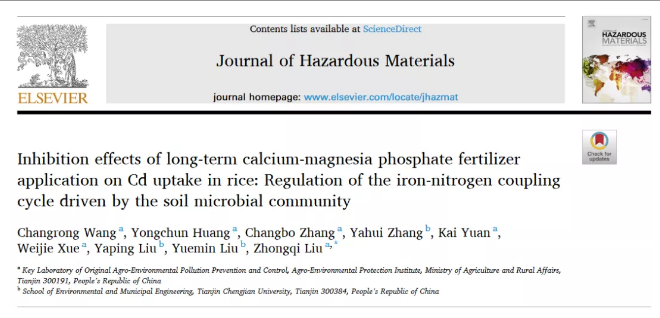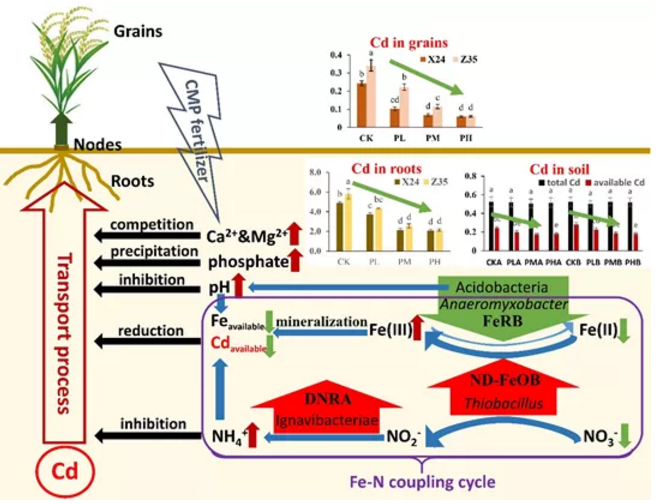Journal of Hazardous Materials:钙镁磷肥抑制水稻镉吸收的微生物学机制
作者: 来源:期刊出版与信息服务中心 2021-05-28

我所刘仲齐研究员团队发现,钙镁磷肥对水稻根际土壤微生物群落结构有显著影响,通过调控菌群驱动的铁氮耦合循环,显著抑制水稻对镉的吸收。相关成果发表于Journal of Hazardous Materials(IF=9.038)。
论文第一作者为王常荣助理研究员,通讯作者为重金属生态毒理创新团队首席科学家刘仲齐研究员,研究工作得到国家重点研发计划和国家自然科学基金等的资助。
Highlights
•CMP fertilizer application reduces Cd and Fe availabilities in paddy soils.
•CMP reduces the NO3-/NH4+ ratio by regulating the soil Fe-N cycle.
•CMP affects soil Fe oxidation-reduction driven by Thiobacillus and Anaeromyxobacter.
•CMP promotes nitrate reduction to ammonium driven by Thiobacillus and Ignavibacteriae.
Abstract
Cadmium (Cd) pollution in paddy soil seriously endangers food safety production. To investigate the effects and microbiological mechanisms of calcium-magnesium-phosphate (CMP) fertilizer application on Cd reduction in rice, field experiments were conducted in Cd-contaminated paddy soil. Compared with conventional compound fertilizer, CMP fertilizer treatments inhibited Cd uptake through plant roots, significantly decreasing Cd content in rice grains from 0.340 to 0.062 mg/kg. Soil pH and total Ca, Mg and P contents increased after CMP fertilizer application, resulting in a further decrease in soil available Cd content from 0.246 to 0.181 mg/kg. Specific extraction analysis recorded a decrease in both available Fe content and the ratio of nitrate to ammonium nitrogen, indicating that the soil Fe-N cycle was affected by the addition of CMP fertilizer. This finding was also recorded using soil bacterial community sequencing, with CMP fertilizer promoting the progress of nitrate-dependent Fe-oxidation driven by Thiobacillus (1.60% to 2.83%) and subsequent dissimilatory nitrate reduction to ammonium (DNRA) driven by Ignavibacteriae (1.01% to 1.92%); Fe-reduction driven by Anaeromyxobacter (3.09% to 2.23%) was also inhibited. Our results indicate that CMP fertilizer application regulates the Fe-N coupling cycle driven by the soil microbial community to benefit remediation of Cd contaminated paddy soil.

土壤镉污染问题严重危害粮食安全生产,施加钙镁磷肥能够有效抑制水稻镉吸收积累,本团队前期研究发现钙镁磷肥同时促进了水稻根表铁锰膜的形成和根对氮的吸收,提示营养元素铁和氮在水稻镉吸收过程中可能起到重要的调控作用。本研究以此为基础,进一步利用田间试验,探索钙镁磷肥通过调控菌群驱动的铁氮耦合循环抑制水稻镉吸收的微生物学机制。与当地常用的复合肥相比,施加钙镁磷肥作为基肥显著降低了土壤中有效态镉含量,抑制了水稻根系对镉的吸收,进而使籽粒镉积累量降低到国家安全标准以内。同时,改施钙镁磷肥后,土壤中有效态铁和硝态氮的含量显著降低,而铵态氮的含量显著增加,也就是说,在降低土壤中铁可利用性的同时,提高了铵态氮/硝态氮的比例,表明施加钙镁磷肥能够影响铁-氮循环过程以改变土壤中铁和氮的化学形态。
进一步通过土壤微生物测序证明,施加钙镁磷肥能够改变水稻根际菌群结构及其驱动的铁-氮元素循环过程。其中,铁还原菌Anaeromyxobacter丰度的降低(3.09% ~ 2.23%),抑制了其驱动的铁还原过程;而硝酸盐依赖的铁氧化菌Thiobacillus丰度的提高(1.60% ~ 2.83%),促进了其驱动的铁氧化耦合硝酸盐还原反应,Thiobacillus以硝酸盐为电子受体,在将二价铁氧化为三价铁的同时能够将硝态氮还原成亚硝态氮;进一步,Ignavibacteriae丰度的提高(1.01% ~ 1.92%),也促进了其驱动的硝酸盐异化还原为铵(DNRA)过程的第二步反应,即亚硝酸盐异化还原为铵。也就是说,与传统的氮磷钾肥相比,施用钙镁磷肥能够通过提高水稻根际土壤中关键菌Thiobacillus和Ignavibacteriae的丰度,促进DNRA过程将硝态氮异化还原为铵态氮,而已有研究证明铵态氮能够抑制水稻根对镉的吸收;同时,与硝酸盐还原耦合的铁氧化过程也因铁氧化菌Thiobacillus和铁还原菌Anaeromyxobacter的丰度变化而得到促进,在铁氧化过程中,其矿化不但降低了有效态铁的含量,还能够通过吸附和共沉淀等作用影响镉的生物可利用性。
因此,施用钙镁磷肥通过调控根际土壤微生物群落结构及其驱动的铁氮耦合循环,影响水稻根际营养元素和重金属镉的化学形态,进而抑制水稻对镉的吸收,有利于污染农田的粮食安全生产。(期刊出版与信息服务中心推荐)
责任编辑:宋潇
校对和审核:张阳 王农













